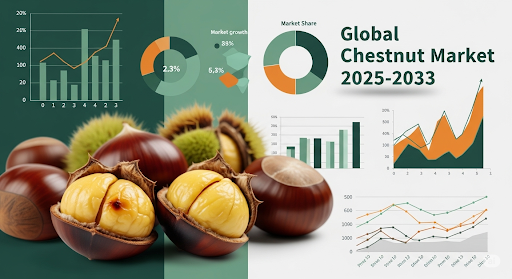
Asia Pacific dominates the global chestnut market, accounting for 39% of the USD 3.8 billion market in 2024. With rising health awareness, culinary versatility, and sustainable farming practices, demand continues to expand. IMARC forecasts this growth to reach USD 5.0 billion by 2033, driven by robust regional production, dietary trends toward plant-based and gluten-free foods, and innovations in cultivation and export infrastructure.
STUDY ASSUMPTION YEARS
- BASE YEAR: 2024
- HISTORICAL YEAR: 2019–2024
- FORECAST YEAR: 2025–2033
CHESTNUT MARKET KEY TAKEAWAYS
- Market size stood at USD 3.8 Billion in 2024, projected to reach USD 5.0 Billion by 2033 at a 3.1% CAGR.
- Asia Pacific leads with ~39% share in 2024, driven by China’s dominance in production and consumption.
- Chinese chestnut tops species-wise share due to high yield, adaptability, and disease resistance.
- Distribution segments: Food & Beverage, Food Service, Retail, and Others, with the F&B sector registering the fastest growth.
- Rising plant-based, gluten-free, and organic trends fuel demand; chestnuts offer a low-fat, vitamin-rich profile.
- Export growth from Asia (China, South Korea, Japan) and Europe is aided by improved storage and transportation technologies.
MARKET GROWTH FACTORS
- Increasing health consciousness
The rising health consciousness regarding chestnuts stems from their distinct nutritional profile, which sets them apart from other nuts and aligns well with current dietary trends. Unlike most nuts, chestnuts are relatively low in fat and calories but are a notable source of complex carbohydrates, which provide sustained energy. This unique macronutrient ratio, combined with a high fiber content, helps regulate blood sugar, promotes satiety, and aids in weight management. Furthermore, chestnuts are the only nut that provides a significant amount of vitamin C, bolstering immunity and providing powerful antioxidant benefits alongside other antioxidant compounds like gallic acid, ellagic acid, tannins, and various polyphenols, which help combat inflammation and oxidative stress associated with chronic diseases. Their naturally gluten-free nature also makes them an excellent ingredient for the growing number of people following gluten-free or plant-based diets, offering a delicious and nutritious alternative to traditional flours and snacks while supporting digestive health and potentially providing other health benefits, including improved cardiovascular health and bone mineral density. - Rising popularity of plant-based and gluten-free diets
The increasing adoption of plant-based and gluten-free diets has significantly boosted the appeal of chestnuts, particularly chestnut flour, as a versatile and nutritious ingredient. Chestnuts are naturally gluten-free, making them a safe and healthy alternative for those with celiac disease or gluten sensitivities, allowing for the creation of bread, pastas, and baked goods that are traditionally off-limits for these individuals. Moreover, chestnuts are a whole food derived from trees, fitting seamlessly into plant-based lifestyles and providing a rich, satisfying base for a wide variety of vegan dishes, from soups and stuffings to decadent desserts. Beyond their dietary suitability, chestnuts contribute valuable nutrition to these diets, being lower in fat compared to most nuts while providing essential vitamins, minerals, and dietary fiber, which supports digestive health and offers a slow-release energy source due to their high carbohydrate content. - Sustainable and organic farming practices
Sustainable and organic chestnut farming combines agroforestry, soil health management, and efficient pest and water strategies to create resilient orchards. This involves integrating chestnut trees with other crops or livestock to enhance biodiversity and ecosystem services, while promoting soil health through organic amendments like compost, mulch, and cover crops, and minimizing disturbance through conservation tillage. Integrated Pest Management (IPM) is employed, prioritizing methods like blight-resistant varieties, biological controls (e.g., specific wasps against gall wasps), and habitat management. Water conservation is crucial, with practices like drip irrigation, rainwater harvesting, mulching, and strategic site selection ensuring efficient water use and minimizing reliance on external sources. By focusing on these interconnected approaches, organic chestnut farming minimizes environmental impact, fosters long-term orchard health, and ensures the sustainable production of chestnuts.
Request for a sample copy of this report:
https://www.imarcgroup.com/chestnut-market/requestsample
MARKET SEGMENTATION
By Species Type:
- American Chestnut: One of the key species types tracked.
- Chinese Chestnut: Leading segment (~39% share) due to yield and disease resistance.
- European Chestnut: Widely used across Europe for snacks, flour, and traditional dishes.
- Japanese Chestnut: Cultivated in East Asia and gaining popularity in regional cuisines.
By Distribution:
- Food and Beverage Industry: Drives growth via bakery, snacks, and beverages, benefiting from nutritional traits.
- Food Service: Chestnuts are utilized in restaurants, soups, pastas, desserts, and seasonal dishes.
- Retail: Available as fresh, roasted, frozen, packaged; meeting home‑cooking trend.
- Others: Includes industrial uses like chestnut flour and pastes.
Breakup by Region:
North America (United States, Canada)
Asia Pacific (China, Japan, India, South Korea, Australia, Indonesia, Others)
Europe (Germany, France, United Kingdom, Italy, Spain, Russia, Others)
Latin America (Brazil, Mexico, Others)
Middle East and Africa
REGIONAL INSIGHTS
Asia Pacific commands the chestnut market with 39% share in 2024, driven by China’s production dominance and deep-rooted chestnut consumption in cuisines across China, South Korea, and Japan. Rising disposable incomes, urbanization, and health awareness have boosted demand. Innovations in cultivation and export infrastructure further reinforce the region’s leadership position.
RECENT DEVELOPMENTS & NEWS
Recent developments reflect the chestnut market’s diversification and scientific progress. Notable advances include large-scale genetic research like the OxO gene project aimed at reviving blight-resistant chestnuts. Export innovation continues, with new convenience products such as Japan’s “chestnut donuts.” Infrastructure upgrades, such as lottery system rollouts in Chestnut Market stores, showcase operational modernization. These trends highlight technological breakthroughs, sustainability focus, and evolving consumer experiences in the chestnut sector.
KEY PLAYERS
Chengde Shenli Food Co. Ltd., Chestnut Growers Inc., Qinhuangdao Yanshan Chestnut Food Co. Ltd., Roland Foods LLC, Royal Nut Company, Shandong Maria Food Co. Ltd, Shandong Zhifeng Foodstuffs Co. Ltd, V. Besana Spa, etc.
Ask Analyst for Customization:
https://www.imarcgroup.com/request?type=report&id=12858&flag=C
If you require any specific information that is not covered currently within the scope of the report, we will provide the same as a part of the customization.
About Us:
IMARC Group is a global management consulting firm that helps the world’s most ambitious changemakers to create a lasting impact. The company provides a comprehensive suite of market entry and expansion services. IMARC offerings include a thorough market assessment, feasibility studies, company incorporation assistance, factory setup support, regulatory approvals and licensing navigation, branding, marketing and sales strategies, competitive landscape, benchmarking analyses, pricing and cost research, and procurement research.
Contact Us:
IMARC Group
134 N 4th St. Brooklyn, NY 11249, USA
Email: sales@imarcgroup.com
Tel No:(D) +91 120 433 0800
United States: (+1-201971-6302)


